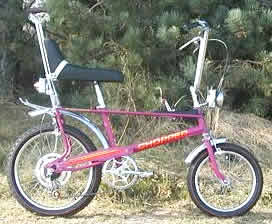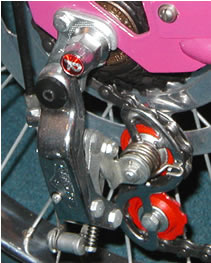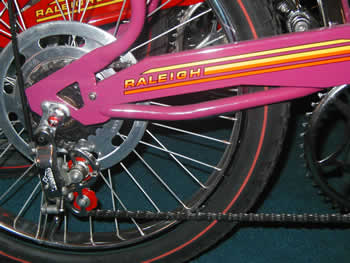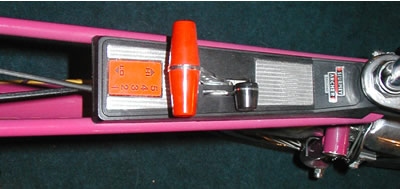Lets
see now...well imagine were in the design department of Raleigh, just
around the end of 1972. The first of the "Special Edition"
Choppers, the racing handlebar "Sprint" has been doing badly
in the marketplace, and Raleigh are planning its replacement. Let's
evesdrop......
"I say Curruthers, why don't we build a Five Speed Mk2 Chopper...we
have proved it works and is reliable over in Anmerica, where we sold
thousands of MK1 5 speeds....."
Good Idea old boy...we need something that will sell really well after
the embarassment of the "Sprint" ...
Are we following this conversation readers? well listen on......
"Yes, we need it to sell really well, so well make it available
in an exclusive colour so everyone will be able to instantly recognise
it as something special..."
PINK!
Yes, they painted it PINK!!!!!!!!
Now, back in the mid 1970s, what kind of boy, eager for a new Raleigh
Chopper would want a PINK bike????
You're right...the ones who were Girls.
No boy would be seen DEAD on a pink bicycle...not in our liberated
modern age, and certainly not in the 1970s.
So, Raleigh's second attempt at a special Chopper died a quiet death.
Girls bought them...but the fact that they were 5 speeds was completely
lost on them...they just wanted a pink Chopper, 'cos it's a girly
colour...
Another great marketing failure by Raleigh.
However, the 5 speeds are very collectable now, and the fact that
they are pink (and rare!) is a talking point.
Gary
Leddingham and his lovely wife Carol are famous for their matching
his 'n' her's pink Chopper 5 speeds .
Here Gary describes them, and defends them!
MK2
Sharp Pink 5 speeds, the Rolls Royce of Choppers?
Some may say yes, but they are not that different. Here’s why…..
Let's start with the obvious bits that are the same. The handlebars
are the same, as are the brakes, front wheel, front mudguard and
wait a minute! This is more difficult than I thought!

Thanks
to Alex Jewell for the picture
Let's
try looking at the bits that are different. Let's start with the
obvious bits (where have I heard that before….?). It has 5
gears! The gears are changed by a shifter which is the same but
different to the 3 speeds. More of that later. The gear change is
by way of a derailleur arm that lifts the chain across 5 different
sized ‘cogs’. This arrangement is (to me at least!) far
easier to understand than the insides of a Sturmey Archer rear hub!
So gear change is by derailleur and 5 ‘cogs’ known as
the ‘free wheel block’ (which on modern bikes are called
the cassette!). That means that the back wheel is very different
as is the rear of the frame. More of that later too!

Thanks
to Alex Jewell for the picture
Back wheel then. This takes the normal ‘Red
line’ rear tyre. The hub/spindle is of course different to
a 3 speed. So are the spokes. They are slightly longer, in fact
the spec sheet says they are different lengths each side! This is
because the gear block is wider on the right side...so the spoke
dish is smaller to allow the wheel rim to sit in the centre of the
frame, but not over the centre of the rear axle. Nothing like keeping
it simple! The rim is the same as the 3 speed. The wheel spindle
is slightly wider than the ‘3’. This is to accomodate
the gear cog, and to clear the chain, the rear frame arms from the
pedals to the rear axle, have a definite bend, or "kick up"
as opposed to the 3 speeds straight tubes.The rear wheel also has
‘R’ nuts on both sides. I think this makes the rear end
look much better than the ‘3’. The rear spoke protector
is different to the three speed,and is the same as some racing bikes
from the period. The spacing in the center is slightly different.

Thanks
to Alex Jewell for the picture
The
frame. This is pretty much the same as the ‘3’ except
for the rear tubes as explained above...and the rear dropouts..
These are the slots that the rear wheel fit into. The ‘3’s
go straight back where as the ‘5’s rake back at an angle.All
this means that no way can a 3 speed be fitted with a ‘5’
speed derailleur! The gap between the drop outs is also wider than
the ‘3’.
The colour (some call it Sharp Pink, some call it Dusky Pink) is
unique to the ‘5’. So to are the decals. Split colours
of Day-Glo Orange and Bright Yellow. These are the same colours
as used on the ‘3’. The chain guard also has these graphics
but is otherwise the same as the ‘3’.
The Chain Wheel is also different to the ‘3’. So is the
Chain. This is because the chain has to be thinner to get between
all 5 of the cogs at the back, and is basically a racing bike chain...they
had derailleurs as well.. This means the Chain Wheel is slimmer
than the ‘3’. The chain wheel does not have the ‘Heron’
logo on it either. The cranks are slightly different too but the
same odd ball length as the three.! The pedals are the same long
reflector type.
The sissy bar, springs and seat stem are the same. I have heard
that some ‘bull-nose’ seats were used on the ‘5’
which did not appear on the ‘3’. I’m not too sure
about this. The rack is the same as the ‘3’. The rear
mudguard seems to have been slightly shorter than the ‘3’.
Don’t know why. All that seems to do is get a nice streak of
mud down your back when you ride in the rain!
The brake callipers are the same as are the levers (with black plastic
covers). The brakes used the usual ribbed cable. The front brakes
also had the ‘hooks’ or stabilisers on them.
Now to the shifter! The two levers functions are misunderstood by
some. The long lever (with red knobs in the UK) changes gear but
does not ‘click’ into place. Also there is no window to
show what gear you are in. I think the ‘click’ was tried
on American ‘5’s but it must have been very difficult
to make the gears ‘align’ correctly. Maybe that’s
why it’s very rare to see this shifter! The small black knob
tensions the large red lever to hold it in gear whilst at speed(?).
The diecast base under the console cover is the same as the ‘3’
with the small lever added to the side of it and the ‘click’
mechanism removed. Simple really! The console cover is different
from the ‘3’ in that the window has a ‘Hi - Low’
sticker over it and an extra slot for the tensioner lever. The gear
cable was smooth as far as I know.

Thanks
to Alex Jewell for the picture
Well,
that’s about it as far as I can remember. . Just one last thing.
The real difference between the 3 speed and the 5 Speed was the
price. It was far more expensive than the 3 speed. Maybe this is
why they are so rare these days? Is this why it’s the Rolls
Royce of Choppers?
Gary and Carol Leddingham.
5 Speed Raleigh Choppers first appeared in Early 1973, suprisingly
priced lower than the mk2, maybe as an "opening offer"
at £36.82 compared to the std bikes £37.50
They managed to survive untill early 1976, by which time they were
£66.95 compared to £62.95 for a std mk2 bike.
They were phased out in early 1976, to be replaced by the third,
and most famous special Chopper...the one they actually called the
"Special Edition"
|





